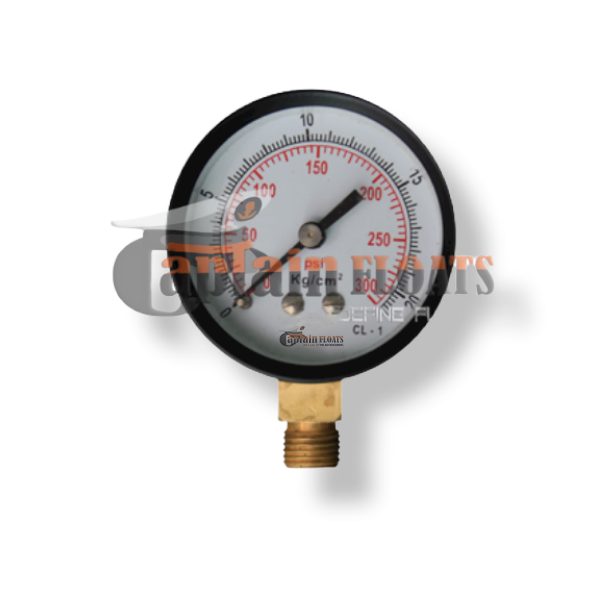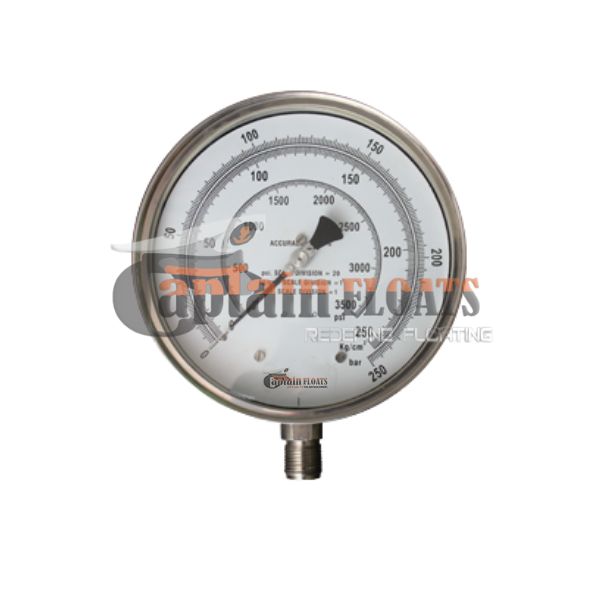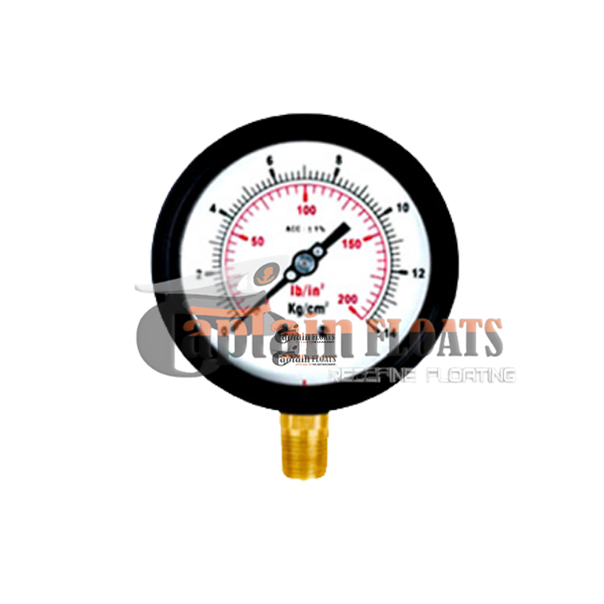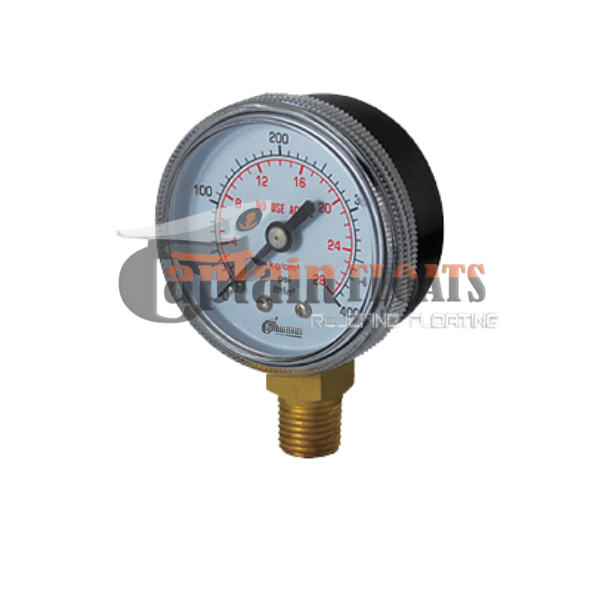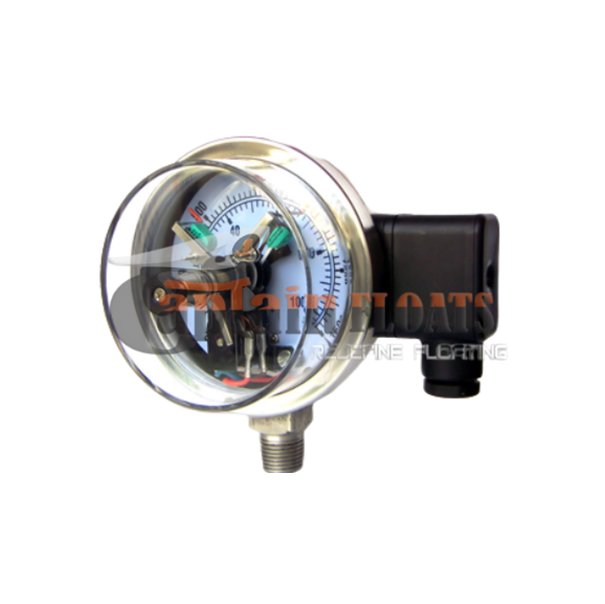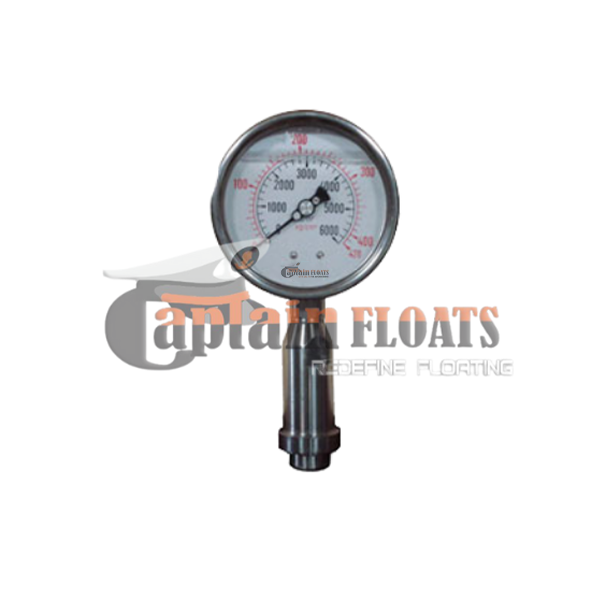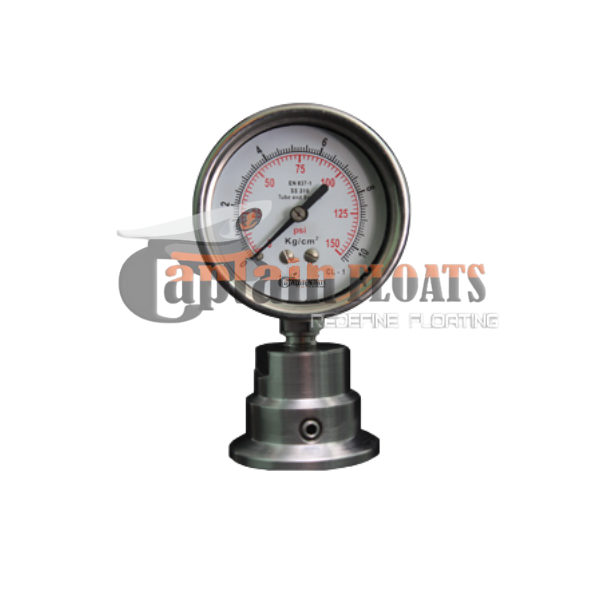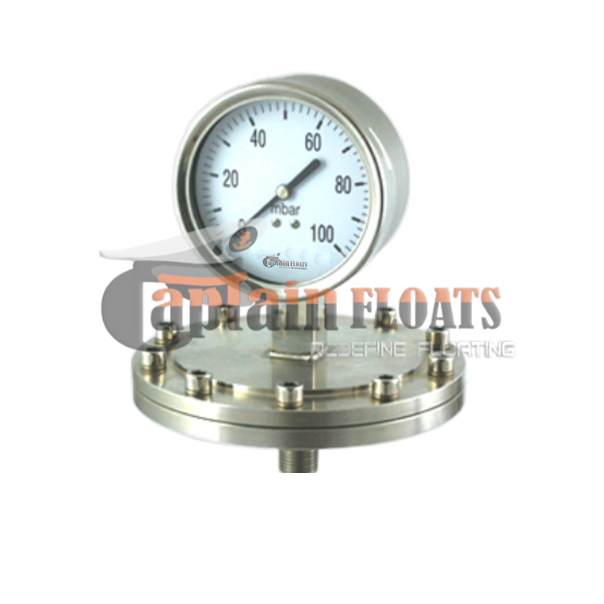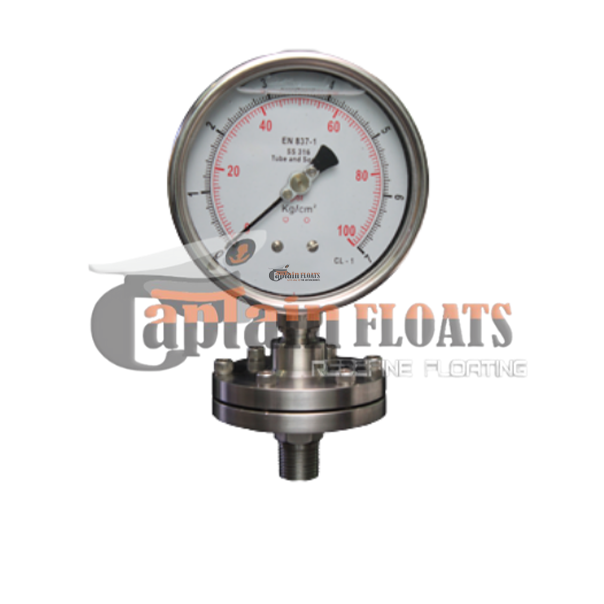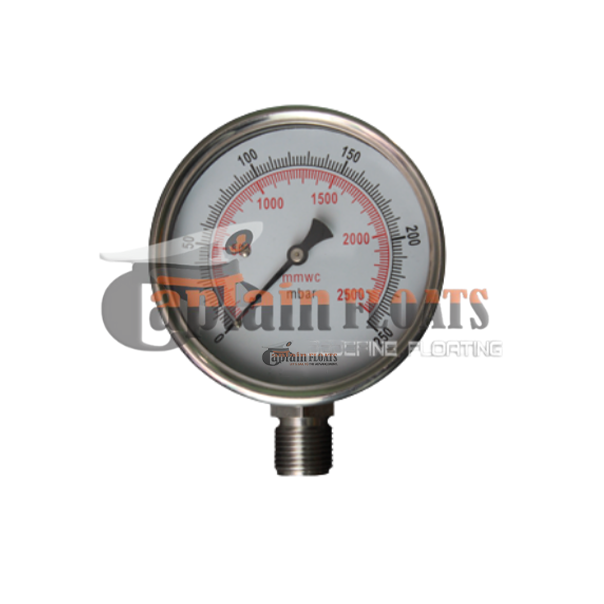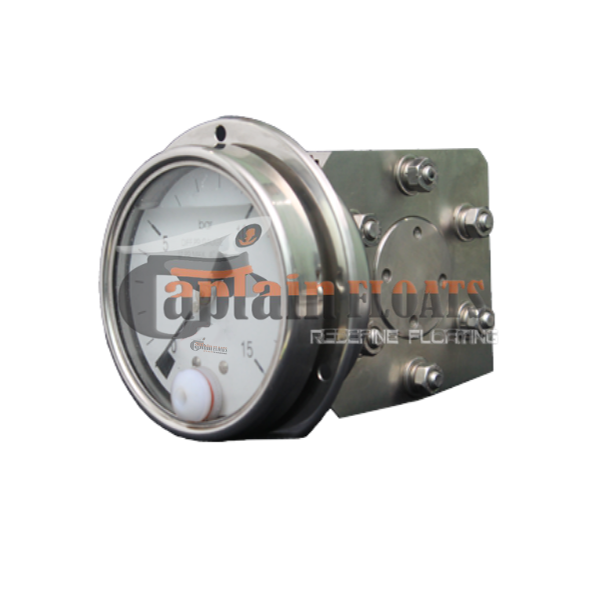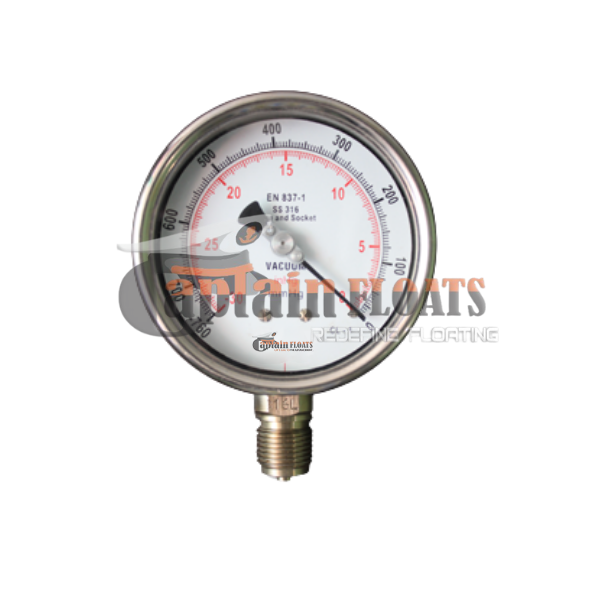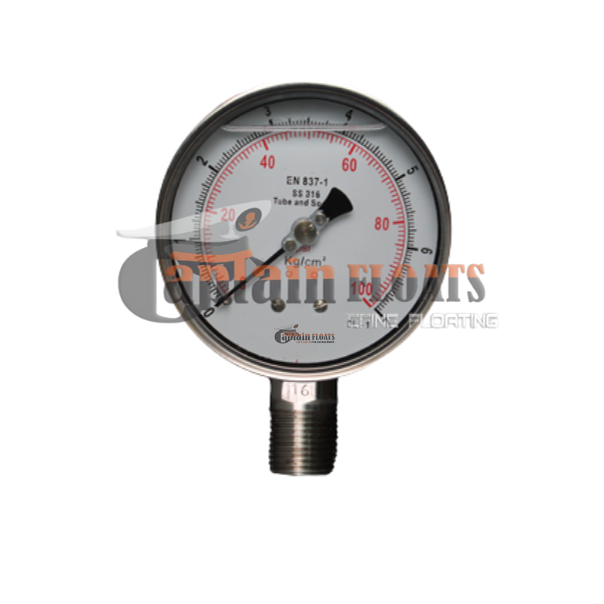PRESSURE GAUGE
You Are Here:
Products / Pressure Gauge
OUR RANGE OF PRESSURE GAUGE
Introducing Captain Floats: Your Premier Pressure Gauge Manufacturer and Exporter. Welcome to the esteemed realm of Captain Floats, where precision, reliability, and innovation converge seamlessly. As a distinguished Pressure Gauge manufacturer and exporter, Captain Floats proudly stands as a beacon of excellence in the realm of industrial instrumentation.
At Captain Floats, our raison d’être revolves around the meticulous craft of engineering precision pressure gauges that transcend mere functionality. As purveyors of precision instruments, our commitment to excellence resonates throughout every facet of our operation, solidifying our standing as the preeminent Pressure Gauge manufacturer and exporter in the industry.
PRESSURE GAUGE SPECIFICATIONS
A device called a Pressure Gauge is used to determine the pressure of a liquid or gas inside of a sealed system. Usually, it is a dial display with a moving needle to show the pressure level. A pressure port or fitting connects the gauge to the system, enabling the fluid to apply force to a sensor element inside the gauge.
Pressure Gauges can measure pressure in a variety of measurements, including pounds per square inch (psi), bar, pascal (Pa), and others. They are available in both analog and digital forms. They are commonly employed to monitor and regulate pressure levels in systems like pipelines, boilers, hydraulic systems, pneumatic systems, and many more in commercial, industrial, and household settings.
Applications for Pressure Gauge are many in a wide range of sectors and industries. Typical uses for them include:
Industrial Processes: To monitor the pressure levels in pipelines, tanks, vessels, and other equipment, Pressure Gauge are widely employed in industrial settings. This covers sectors like manufacturing, food and beverage, oil and gas, petrochemicals, power generation, and chemical processing.
HVAC Systems: To guarantee maximum performance and efficiency, heating, ventilation, and air conditioning (HVAC) systems use Pressure Gauge to measure the air or refrigerant pressure inside ducts, pipes, and HVAC equipment.
Automotive Industry: Tire pressure, engine oil pressure, fuel pressure, and hydraulic system pressure in cars and other machinery are all monitored by Pressure Gauge, which are crucial in automotive applications.
Medical Equipment: Blood pressure monitors, anesthetic machines, ventilators, and dialysis machines are just a few examples of the systems that use Pressure Gauge to measure and keep track of pressure.
Aviation & Aerospace: To guarantee safe operation, Pressure Gauge are essential in aircraft and aerospace applications for monitoring fuel, hydraulic, pneumatic, and cabin pressure.
Water Management: To monitor water pressure and flow rates, Pressure Gauge are used in water management systems, such as water distribution networks, pumping stations, and wastewater treatment plants.
Research and Laboratory Equipment: In scientific investigations and research labs where accurate pressure measurements are required, including in chemical reactors, vacuum systems, and pressure chambers, pressure gauges are essential.
Fire Suppression Systems: To show pressure levels and guarantee preparedness for firefighting operations, Pressure Gauge are utilized in fire suppression systems, such as fire sprinkler systems and fire extinguishers.
Hydraulic and Pneumatic Systems: In order to ensure the safe and effective functioning of hydraulic and pneumatic systems, such as hydraulic machinery, pneumatic tools, and hydraulic lifts, pressure gauges are essential parts of the system.
Environmental Monitoring: For meteorological, oceanographic, and environmental research objectives, atmospheric, oceanic, and groundwater pressures are measured using Pressure Gauges in environmental monitoring apparatus.
These are only a few instances of the wide range of uses for Pressure Gauges in numerous sectors and industries, highlighting how crucial they are for preserving operational effectiveness, security, and quality in a range of systems and processes.
In order to guarantee correct operation and precise readings, installing a Pressure Gauge usually requires multiple stages. This is a basic how-to for mounting a pressure gauge:
Decide on the Location: Select a convenient spot where the Pressure Gauge can be seen and accessible with ease. Make that the placement is appropriate for the fluid type and pressure range being measured.
Set Up the Connection: If required, set up the system connection point where the Pressure Gauge is going to be mounted. This could entail taking off any plugs or protective caps from the pressure port.
Apply Thread Sealant (if applicable): To stop leaks, if the Pressure Gauge has a threaded connection, coat the threads with the proper thread sealant or thread tape.
Attach the Pressure Gauge: Gently insert the Pressure Gauge into the system’s fitting or pressure port. If required, use a wrench to firmly tighten the connection; however, take care not to overtighten as this could harm the gauge or the system.
Calibrate (if necessary): To ensure accuracy, the Pressure Gauge may need to be calibrated prior to installation, depending on the application and requirements. If there are calibration instructions, go to the manufacturer’s instructions.
Check for Leaks: Following the installation of the Pressure Gauge, look for any leaks near the connection point. If leaks occur, stop them by tightening the connection even more or adding more sealant as needed.
Check Operation: Following installation, apply pressure to the system and check the gauge’s readings to make sure it is working properly. Make that the readings correspond to the system’s anticipated pressure levels.
Protect and Secure: After the Pressure Gauge has been placed and checked, use mounting brackets or other suitable techniques to firmly anchor it to avoid damage or movement. To protect the gauge from environmental dangers or unintentional impacts, think about putting protective coverings or guards in place.
Installing a Pressure Gauge requires documentation. For future reference and upkeep, keep a file with the location, installation date, calibration information (if applicable), and any other pertinent details.
Routine Maintenance: Check the Pressure Gauge occasionally for indications of wear, damage, or errors. For sustained dependable functioning, adhere to the manufacturer’s recommended maintenance and calibration intervals.
These instructions will help you install a Pressure Gauge correctly so that it can measure and track pressure levels in a range of systems and applications. Seek advice from a competent technician or refer to the manufacturer’s instructions if you have any questions concerning any stage of the installation process.
A pressure gauge needs to be maintained in order to provide reliable readings and increase its longevity. Here is a quick tutorial on how to maintain a Pressure Gauge:
Frequent Inspection: Check the Pressure Gauge on a regular basis for indications of wear and tear, such as cracked dials or casing, bent needles, or fluid leaks around the connection point.
Calibration: To ensure the accuracy of the pressure gauge, calibrate it periodically in accordance with the manufacturer’s guidelines and the needs of the application. If calibration is not possible, this may entail replacing the gauge or altering it to fit a recognized standard.
Cleaning: Keep debris, dust, and other impurities away from the pressure gauge to avoid affecting its functionality. Regularly wipe the dial and housing with a soft, dry cloth. Steer clear of chemicals or harsh cleansers that could harm the gauge.
Protective Measures: To protect the pressure gauge from environmental dangers such high temperatures, wetness, or physical impact, install covers or guards. This guarantees dependable operation and aids in damage prevention.
Examine Seals and Connections: Look for any indications of degradation or wear on the pressure gauge’s seals and connections. To stop fluid leaks, fix loose connections or replace damaged seals.
Operational Checks: To test the pressure gauge on a regular basis, pressurize the system and compare the gauge readings to a calibrated gauge or a known standard. Check to see if the gauge reacts precisely and reliably.
Maintenance Documentation: Maintain thorough records of all maintenance operations, including dates of inspection, results of calibrations, and details of repairs and replacements. This guarantees adherence to maintenance plans and aids in tracking the pressure gauge’s history.
Replace When Necessary: To ensure accurate pressure measurement, replace the pressure gauge if it exhibits noticeable wear, damage, or inaccuracy that cannot be fixed with maintenance.
You can make sure that your pressure gauge lasts the full length of its service life, gives accurate readings, and functions well by according to these maintenance procedures. Seek advice from a competent technician or consult the manufacturer’s instructions if you have any questions regarding any maintenance procedures.
A Pressure Gauge’s accuracy and dependability are guaranteed by calibrating it. The following is a general guide to pressure gauge calibration:
Assemble Calibration Equipment: A reference standard pressure source that can deliver known pressure values, such as a calibrated pressure calibrator or deadweight tester, is required. Make sure the calibration tools match the gauge’s pressure range that needs to be calibrated.
Set Up a Stable and Clean Environment: Make sure the calibration area is free from breezes and vibrations that could skew the results.
Check Calibration Equipment: Make that the calibration equipment is within its valid calibration period and is properly calibrated before beginning. This guarantees that the reference pressure values are accurate.
Attach Pressure Gauge: Using the proper fittings and adapters, attach the Pressure Gauge to the calibration apparatus. To avoid leakage, make sure the connection is secure. Set the calibration apparatus to the appropriate pressure level in order to adjust it. This ought to encompass the range of pressures that the gauge will normally come into contact with.
Take Notes: When applying pressure, take note of the readings on the calibrated Pressure Gauge as well as the standard pressure source reference.
Comparison of Readings: Check the agreement between the Pressure Gauge’s readings and those obtained from the standard reference pressure source. Make a note of any differences between the two readings.
Adjust Gauge (if necessary): If the Pressure Gauge’s readings differ from the reference standard, make the required gauge changes to fix the discrepancy. This could entail utilizing adjustment screws or knobs to change the gauge’s span or zero point.
Repeat Calibration Points: Throughout its operating range, and particularly at critical pressure levels, calibrate the Pressure Gauge several times. For every pressure point, repeat the calibration procedure, and make any necessary gauge adjustments. Keep a record of the calibration process by recording the pressure readings that were acquired from the gauge and the reference standard, together with any modifications that were made to the gauge. Note the time, date, and participants in the calibration procedure.
Label Calibration: Attach a calibration label or tag with the calibration date, the next due date, and any pertinent information after the calibration is finished and the Pressure Gauge satisfies the necessary accuracy standards.
Check Accuracy: Following calibration, compare the pressure gauge’s readings with pressure levels that are known to exist in practical applications to ensure accuracy.
You may successfully calibrate a Pressure Gauge to guarantee precise and trustworthy pressure measurements by following these steps. Seek advice from trained individuals or calibration service providers if you are not comfortable with dealing with high-pressure equipment or calibration methods.
There are numerous varieties of pressure gauges made to measure various pressures and be used for different purposes. These are a few typical kinds:
The most popular kind of Pressure Gauge is the Bourdon Tube Pressure Gauge, which is made of a curved tube that distorts when pressure is applied. To show pressure, a pointer on a dial is mechanically connected to the movement of the tube.
Diaphragm Pressure Gauge: Diaphragm Pressure Gauge measure pressure by means of a flexible diaphragm. The diaphragm flexes in response to changes in pressure, producing a movement that is translated into a measurement of pressure.
Bellows Pressure Gauge: To measure pressure, bellows Pressure Gauge use a foldable bellows-like frame. The bellows expands or contracts in response to pressure changes, and this movement is translated into a pressure reading.
Manometer: A manometer is a basic instrument that weighs a liquid in a tube and compares its weight to the pressure of a gas to determine pressure. It is frequently utilized for low-pressure measurements and comes in a variety of designs, including well-type, inclined, and U-tube manometers.
Digital Pressure Gauge: Digital Pressure Gauge detect pressure using electronic sensors and show the results digitally. They frequently provide extra features including digital communication capabilities, alarm features, and data logging.
Differential Pressure Gauge: This type of gauge calculates the pressure differential between two places. Applications including flow measuring, level measurement, and filtration monitoring frequently employ them.
Absolute Pressure Gauge: This type of gauge calculates pressure in relation to an ideal vacuum. They are frequently employed in vacuum systems and altitude measurements, among other applications where it is vital to take atmospheric pressure into consideration.
Compound Pressure Gauge: To monitor both positive and negative pressures, compound Pressure Gauge incorporate elements from vacuum and pressure gauges. Applications where pressure can vary both above and below atmospheric pressure frequently use them.
Sealed Pressure Gauge: Made to resist corrosive media or severe environmental conditions, sealed Pressure Gauge are built to last. To prevent contamination of internal components, they are frequently hermetically sealed.
Specialty Pressure Gauges: These include submersible Pressure Gauge for undersea applications, high-pressure gauges for hydraulic systems, and sanitary pressure gauges for the food and pharmaceutical sectors, among others, that are made for particular uses.
These are only a few of the popular varieties of Pressure Gauge that are available; each is appropriate for a particular range of pressures, uses, and environmental factors. Selecting the appropriate kind of Pressure Gauge relies on the particular needs of your application.
OUR PRODUCTS
Factory Sale 304 SS Float Level Switch
Multi-Point SS Float Level Switch
PP Float Switch Sensor Liquid Level Controller
Factory Direct Sale Float Level Switch Sensor For Water Humidifier
Single Floating Ball SS Float Level Switch
Double Floating Balls Stainless Steel Float Level Switch

